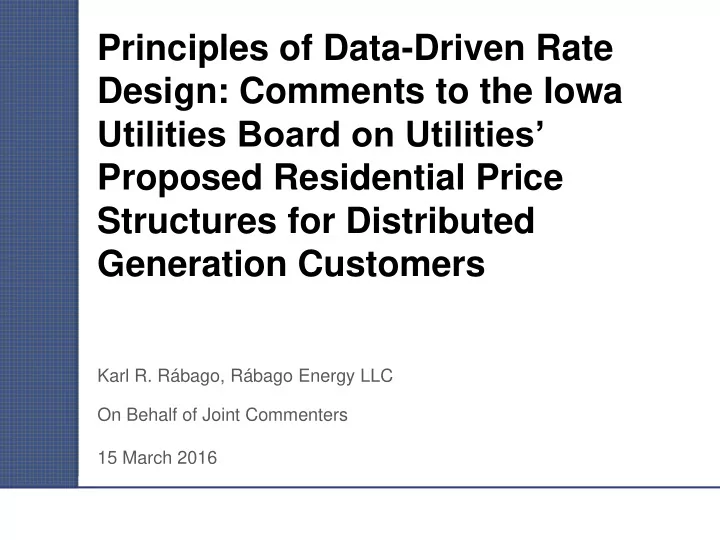

Principles of Data-Driven Rate Design: Comments to the Iowa Utilities Board on Utilities’ Proposed Residential Price Structures for Distributed Generation Customers Karl R. Rábago, Rábago Energy LLC On Behalf of Joint Commenters 15 March 2016
Summary of Comments 1. The record and facts before you have not changed in any material way since the IUB order was issued in Docket NOI 2014-0001. 2. Utility proposals for a new customer-generator rate class are premature, and not adequately supported by data. Market penetrations are still too small: – MidAmerican at 0.05%; IPL at 0.37%; NV Power at 2.0% 3. This may be the time to launch a careful, objective, and public process to develop a benefit-cost assessment methodology (a methodology for “Value of Solar” analysis) in order to reduce unsubstantiated assertions about the system impacts of customer-generators. Rábago – Joint Commenters - IUB 15 March 2016 2
Principles for Modern Rate Design Principle 1: A customer should be able to connect to the grid for no more than the cost of connecting to the grid. Principle 2: Customers should pay for grid services and power supply in proportion to how much they use these services and how much power they consume. Principle 3: Customers who supply power to the grid should be fairly compensated for the full value of the power they supply. Regulatory Assistance Project, “Smart Rate Design for a Smart Future,” available at: www.raponline.org/document/download/id/7680 Rábago – Joint Commenters - IUB 15 March 2016 3
Data Must Drive Rate Design • Utilities have not yet presented adequate data. • “Typical” data is not adequate to support a new rate class. • Data must be robust and normalized – it should be based on several years’ worth of raw data. • Data sets must reflect statistically valid sample sizes. • A deliberate process will create time and allow collection of needed data. • Developing the methodology first will reveal the necessary data sets. “In God we trust; all others must bring data.” – W. Edwards Deming Rábago – Joint Commenters - IUB 15 March 2016 4
Data Requirements (to start) • Five or ten-year forward price of natural gas, the most likely fuel for marginal generation, along with longer-term projections in line with the life of the DSG • Hourly load shapes, by customer class to analyze the intra-class and inter-class impacts • Hourly production profiles, including south- and west-facing arrays • Hourly line loss data, to assess marginal avoided line losses • Initial capital costs, and the fixed and variable O&M costs for the utility’s marginal generation unit • Distribution planning costs, including capital and O&M (fixed and variable) of constructing and operating distribution upgrades necessary to meet load, over the long term • Hourly load data for individual distribution circuits, particularly those with current or expected higher than average penetrations of DSG, in order to capture the potential for avoiding or deferring circuit upgrades Rábago – Joint Commenters - IUB 15 March 2016 5
Maine Value of Solar Study Placeholder, Utility Data Not Available, or No Planned System Investments Rábago – Joint Commenters - IUB 15 March 2016 6
Source: Environment America, “Shining Rewards,” Jun 24, 2015 http://www.environmentamerica.org/reports/amc/shining-rewards Rábago – Joint Commenters - IUB 15 March 2016
Source: Environment America, “Shining Rewards,” Jun.24, 2015 http://www.environmentamerica.org/reports/amc/shining-rewards Rábago – Joint Commenters - IUB 15 March 2016
Thank you! Karl R. Rábago Rábago Energy LLC karl@rabagoenergy.com 512.968.7543 www.rabagoenergy.com @rabagoenergy Rábago – Joint Commenters - IUB 15 March 2016 9
Solar Value: Data-Driven Principles for Rate Design Karl R. Rábago Rábago Energy LLC 15 March 2016 Rábago – Joint Commenters - IUB 15 March 2016
Technical Analysis • Marginal PV resource, derived from a PV fleet production profile • Load analysis period (1 or more years) • Economic study period (life or 1 st yr) • PV system rating convention • System and distribution load data • Effective load carrying capability (ELCC) • Peak load reduction • Loss savings analysis * Source: Clean Power Research Rábago – Joint Commenters - IUB 15 March 2016 11
Economic Analysis • Avoided energy costs • Avoided cost of resource adequacy • Voltage regulation • Avoided transmission capacity cost • Avoided distribution capacity cost • “Out of market” benefits – Avoided residual environmental costs – Fuel price guarantee * Source: Clean Power Research Rábago – Joint Commenters - IUB 15 March 2016 12
Implementation Options • Evaluation of NEM rates • Community shared solar issues • Value of exported energy • Application to other DER technologies • Real time pricing with AMI • Value of solar tariffs * Source: Clean Power Research Rábago – Joint Commenters - IUB 15 March 2016 13
Adjustments to Gross Value Rábago – Joint Commenters - IUB 15 March 2016 14
Distributed Solar Valuation: “A Regulator’s Guidebook” Available through: http://irecusa.org Rábago – Joint Commenters - IUB 15 March 2016 15
Thank you! Karl R. Rábago Rábago Energy LLC karl@rabagoenergy.com 512.968.7543 www.rabagoenergy.com @rabagoenergy Rábago – Joint Commenters - IUB 15 March 2016 16
Recommend
More recommend